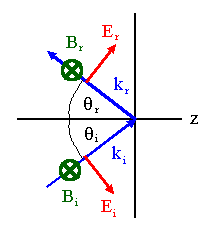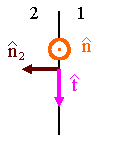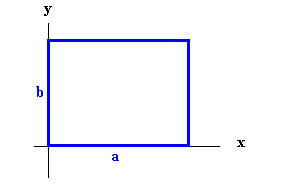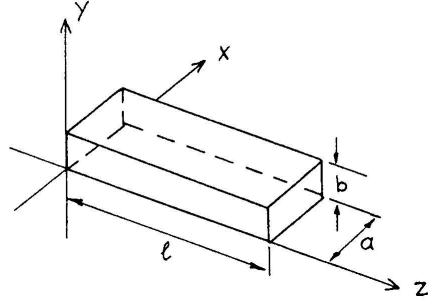Perfect conductor boundaries, Waveguides
Problem:
(a) Beginning with the free Maxwell equations in unbounded space, show that
the propagation of an electromagnetic wave is transverse. That is, show
that the electric and magnetic fields oscillate in a plane perpendicular to the
direction of propagation and perpendicular to each other.
(b) Now, consider the reflection of a plane electromagnetic wave from a flat
perfect conductor. Note that a perfect conductor develops a charge and
current distribution on the surface so that external fields do not penetrate it.
Find the charge and current densities on the conductor for the case of
polarization in the plane of incidence.
Solution:
- Concepts:
Maxwell's equations, boundary conditions
- Reasoning:
Maxwell's equations in free space yield the wave equation for both
E and
B.
They can also be used to show that E ⊥
B.
E ⊥ k.
B ⊥
k. B = (μ0ε0)½(k/k)×E.
- Details of the calculation:
(a) Maxwell's equations:
∇∙E = ρ/ε0,
∇×E = -∂B/∂t, ∇∙B = 0,
∇×B = μ0j + (1/c2)∂E/∂t.
Assume ρf and jf
are zero in the medium. Then
∇×(∇×E)
= ∇(∇∙E)
- ∇2E = -(∂/∂t)(∇×B)
= -μ0ε0∂2E/∂t2.
∇2E = μ0ε0∂2E/∂t2.
∇×(∇×B)
= ∇(∇∙B)
- ∇2B = μ0ε0(∂/∂t)(∇×E) = -μ0ε0∂2B/∂t2.
∇2B = μ0ε0∂2B/∂t2.
Each Cartesian component of E and
B satisfies the 3-dimensional,
homogeneous wave equation.
Plane wave solutions E = E((k/k)∙r
- ct). B = B((k/k)∙r
- ct) exist. (k/k denotes the direction of propagation.)
Let u = (k/k)∙r
- ct.
∇∙E = ∂Ex/∂x + ∂Ey/∂y
+∂Ez/∂z
= (∂Ex/∂u)(kx/k)
+ (∂Ey/∂u)(ky/k)
+(∂Ez/∂u)(kz/k)
= (∂/∂u)(E∙(k/k))
= 0.
E∙k = constant = 0 if we are not
interested in static fields.
∇∙E = 0
requires that E∙k = 0 for radiation fields,
i.e. that E is perpendicular to
k.
Similarly, ∇∙B
= 0 requires that B∙k = 0 for radiation
fields.
∇×E = -∂B/∂t
requires that ((k/k)×E
= cB. i.e. B is perpendicular to
E and k.
[(∇×E)x = ∂Ez/∂y - ∂Ey/∂z
= (∂Eu/∂u)(ky/k)
- (∂Ey/∂u)(kz/k)
= (∂/∂u)((k/k)×E)x
= -∂Bx/∂t = (∂Bx/∂u)c.
If we are not interested in static fields then ((k/k)×E)x
= cBx.
Repeating this derivation for the y- and z- components we have ((k/k)×E
= cB.]

(b) The tangential component of
E is continuous at z = 0.
This implies Eicos(θ) = Ercos(θ)
at z = 0, Ei = Er.
The normal component of
E then is Eisin(θ)
+ Ersin(θ) = 2Eisin(θ).
The surface charge density is σ =
ε02Eisin(θ).
[(E2 - E1)∙n2 = σ/ε0 ]
The tangential component of B at the z < 0 side of the surface is Br
+ Bi = 2Bi.
Therefore 2Bi/μ0
= k. (Here k = surface current density.) [(B2 -
B1)∙t =
μ0k∙n]

Problem:
Consider a rectangular conducting
waveguide of width a (along the x axis) and height b (along the y axis).
An EM wave of wavelength λ travels into the guide
along the z axis; the amplitude of the wave has the form Ey = E0sinkxx.
Derive the form of the guided wavelength and discuss the meaning of the critical
(cutoff) wavelength.
Solution:
- Concepts:
Waveguides, boundary conditions
- Reasoning:
In a rectangular channel with its axis in the z-direction TE0n
waves of the form E = E0sinkxx
exp(i(kzz-ωt)) j can propagate. They have to satisfy the wave equation and the
boundary conditions
E∙t
= 0 and B∙n
= 0 on the walls of the channel. These conditions can only be satisfied
if ω < ωc,
where ωc
is called the cutoff frequency.
- Details of the calculation:

A wave traveling into the z-direction that satisfies the boundary conditions
E∙t
= 0 on the walls if we have E = E0sinkxx
exp(i(kzz-ωt)) j. kxa = nπ.
The wave equation requires
∇2Ey = (1/c2)∂2Ey/∂t2
or kx2Ey + kz2Ey
- (ω2/c2)Ey = 0.
kx2 + kz2 = (ω2/c2).
Since we know kx we can solve for kz.
kz = ((ω2/c2) - (nπ/a)2)½.
Check if B satisfies the boundary conditions
B∙n
= 0 at the walls:
∇×E = -(∂Ey/∂x)(z/z)
+ (∂Ey/∂z)(x/x)
= iωB.
B = [(kz/ω)E0sinkxx(x/x)
+ (ikx/ω))E0coskxx(z/z)]
exp(i(kzz-ωt)).
B∙n
= 0 on the walls.
The wave satisfies the wave equation and the boundary conditions.
The electric field is transverse to the channel, we have a TE wave.
The mode is TE0n.
kz becomes imaginary and the wave does not propagate if
(ω2/c2) < (nπ/a)2
or ω < nπc/a.
λ = 2πc/ω.
If λ > λc
= 2a/n then the TE0n mode cannot propagate.
If a > b then λc = 2a is the cutoff
wavelength for all TE modes.
Problem:
A rectangular waveguide of sides a = 7.21cm and b = 3.40cm is used in the
transverse magnetic (TM) mode. Assume that the walls are perfect
conductors.
(a) By calculating the lowest cut off frequency, determine whether TM radiation
of angular frequency ω = 6.1*1010 s-1
will propagate in the waveguide.
(b) What is the dispersion relation for this guide?
(c) Find the attenuation length for a frequency ω
that is half the cut off frequency.
Solution:
- Concepts:
Waveguides, boundary conditions
- Reasoning:

A TM wave is a superposition of waves of the form
B = B0xsinkxx
exp(i(kzz-ωt)) i + B0ysinkyy
exp(i(kzz-ωt)) j,
with kxa = nπ,
kyb = mπ, with m and n nonzero, positive integers.
These waves is called the TMnm modes of the waveguide.
TM10 or TM01 guided waves do not exist.
- Details of the calculation:
(a) Bx = B0xsinkxx
exp(i(kzz-ωt)),
By = B0ysinkyy
exp(i(kzz-ωt).
B∙n
= 0 on the walls requires
kxa = nπ,
kyb = mπ,
with m and n nonzero, positive integers.
We need ∇∙B = 0, ∂Bx/∂x
+ ∂By/∂y =
0.
This yields kxB0xcoskxx
+ kyB0ycoskyy
= 0,
B0x = -B0y(kysinkyy)/(kxcoskxx).
If we choose B0y = kxB0coskxx
and B0x = -kyB0coskyy
then the equation is satisfied.
We have B = (-kycoskyy
sinkxx
i + kxcoskxx sinkyy
j)B0exp(i(kzz-ωt))
The wave equation requires ∇2B - (1/c2)∂2B/∂t2
= 0.
kx2B + ky2B + kz2B
- (ω2/c2)B = 0.
kx2 + ky2 + kz2 = (ω2/c2).
Since we know kx and ky we can solve for kz.
kz = ((ω2/c2) - (nπ/a)2
- (mπ/b)2)½.
The cutoff frequency for the TMnm mode is ωc
= c((nπ/a)2 + (mπ/b)2)½.
The cutoff frequency for the TM11 mode is ωc
= c((π/a)2 + (π/b)2)½
= 3.1*10-10 s-1, so TM radiation of angular
frequency ω = 6.1*1010 s-1
will propagate in the waveguide.
- (b) The dispersion relation gives ω as
a function of kz.
ω = c(kz2
+ (nπ/a)2 +(mπ/b)2)½.
(c) kz = (1/c)(ω2
- ωc2)½.
If ω
= ωc/2
then kz = (i/c)(√3)ωc/2.
We have: B proportional to exp(-kzz)
= exp(-(√3)ωcz/(2c)).
Therefore: Power P proportional to B2
proportional to exp(-(√3)ωcz/c).
We want: P(z)/P(0) = 1/e, z = c/(√3)ωc
= 3*108 m/(3.1*10-10*√3) =
5.6*10-3 m.
Problem:
A rectangular waveguide made of perfectly conducting
material has sides of length a and b as shown in the figure below.

The ends of a section of length l are covered with plates
of conducting material, i.e. the waveguide is effectively a resonant cavity.
If the electric field is given by the real part of
E(x,y,z,t) = E0(x,z)eiωt
j,
what is ω for the cavity mode
with the lowest resonant frequency?
Solution:
- Concepts:
Maxwell's equations, waveguides, resonant cavities
- Reasoning:
The electric field in the cavity must satisfy Maxwell's equations and the
boundary conditions
E∙t
= 0 and B∙n
= 0 on the walls of the cavity.
- Details of the calculation:
Given: E(x,y,z,t) = E0(x,z)eiωt
(y/y), B
proportional to eiωt.
The field has to satisfy Maxwell's equations. Does it?
∇∙E = 0, ∂Ey/∂y
= 0. This equation is satisfied.
∇×E = -(∂Ey/∂z)(x/x)
+ (∂Ey/∂x)(z/z)
= -∂B/∂t = -iωB.
This implies that B = (1/(iω))(∂Ey/∂z)(x/x)
- (1/(iω))(∂Ey/∂x)(z/z).
∇∙B
= (1/(iω))[∂2Ey/∂x∂z
- ∂2Ey/∂z∂x]
= 0. This equation is satisfied.
B = Bx(x,z)(x/x) + Bz(x,z)(z/z).
∇×B = [∂Bx/∂z)
- (∂Bz/∂x)](y/y)
= (1/c2)∂E/∂t
= (iω/c2)E0(x,z)eiωt
(y/y).
The given field satisfies Maxwell's equations.
If we choose E0(x,z) = Asin(kxx)sin(kzz) with kxa = nπ, kzl =
mπ, then
E∙t
= 0 is satisfied on all walls.
With this choice Bx = (1/(iω))kzAsin(kxx)sin(kzz),
Bx = 0 at x = 0 and x = a.
Bz = (-1/(iω))kxAsin(kxx)sin(kzz),
Bz = 0 at z = 0 and z = l.
B∙n
= 0 is satisfied on all walls.
[∂Bx/∂z) - (∂Bz/∂x)]
= (iω/c2)E0(x,z)eiωt
requires -(1/(iω))kz2 - (1/(iω))kx2
= (iω/c2).
-kz2 - kx2 + ω2/c2
= 0. ω2/c2 = (mπ/l)2
+ (nπ/a)2.
The lowest resonance frequency in the cavity is ω =
c*[(π/l)2 + (π/a)2]½.



